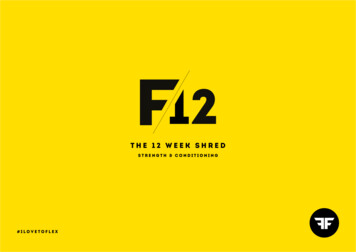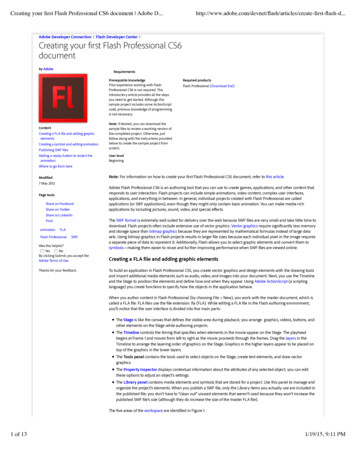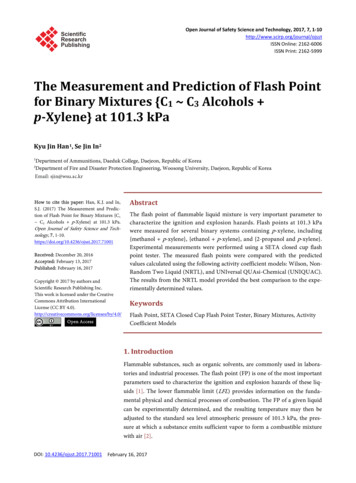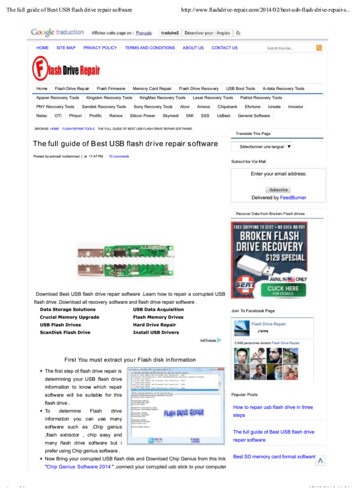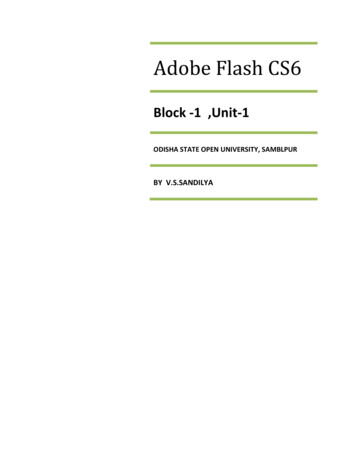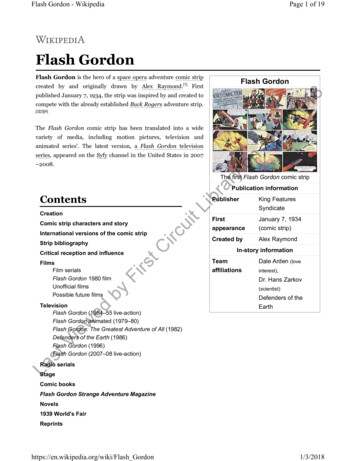
Transcription
Flash Gordon - WikipediaPage 1 of 19Flash GordonFlash Gordon is the hero of a space opera adventure comic stripFlash Gordoncreated by and originally drawn by Alex Raymond.[1] First018published January 7, 1934, the strip was inspired by and created tocompete with the already established Buck Rogers adventure strip.11/2[2][3][4]The Flash Gordon comic strip has been translated into a wide1/variety of media, including motion pictures, television andanimated series'. The latest version, a Flash Gordon televisiononseries, appeared on the Syfy channel in the United States in 2007y–2008.rarThe first Flash Gordon comic stripPublication informationPublisherKing FeaturesSyndicateFirstappearanceJanuary 7, 1934(comic strip)Created byAlex RaymondtLibContentsCreationCStrip bibliographybyFirstCritical reception and influenceFilmsFilm serialsFlash Gordon 1980 filmUnofficial filmsPossible future filmsircInternational versions of the comic stripuiComic strip characters and storyTeamaffiliationsDale Arden (loveinterest),Dr. Hans Zarkov(scientist)Defenders of theEarthstViewedTelevisionFlash Gordon (1954–55 live-action)Flash Gordon animated (1979–80)Flash Gordon: The Greatest Adventure of All (1982)Defenders of the Earth (1986)Flash Gordon (1996)Flash Gordon (2007–08 live-action)In-story informationLaRadio serialsStageComic booksFlash Gordon Strange Adventure MagazineNovels1939 World's FairReprintshttps://en.wikipedia.org/wiki/Flash Gordon1/3/2018
Flash Gordon - WikipediaPage 2 of 19GamesDVD releasesFilm serials (1936–1940)Flash Gordon (1936)Flash Gordon's Trip to Mars (1938)Flash Gordon Conquers the Universe (1940)11/2018Flash Gordon (1954–55)The New Adventures of Flash Gordon (1979)Flash Gordon (1980)Defenders of the EarthFlash Gordon (1996)Parodies1/ReferencesonExternal linksraryCreationThe Buck Rogers comic strip had been very commercially successful, spawning novelizations and children's toys,[5]iband King Features Syndicate decided to create their own science fiction comic strip to compete with it.[2] At firsttLKing Features tried to purchase the rights to the John Carter of Mars stories by Edgar Rice Burroughs; however,uithe syndicate was unable to reach an agreement with Burroughs.[6] King Features then turned to Alex Raymond,ircone of their staff artists, to create the story.[3][5] Raymond's first samples were dismissed for not containing enoughaction sequences. Raymond reworked the story and sent it back to the syndicate, who accepted it. Raymond wasCpartnered with ghostwriter Don Moore, an experienced editor and writer.[5] Raymond's first Flash Gordon storyrstappeared in January 1934, alongside Jungle Jim. The Flash Gordon strip was well received by newspaper readers,becoming one of the most popular American comic strips of the 1930s.[2][3][5] Like Buck Rogers, the success ofbytoy spaceships and rayguns.[7]FiFlash Gordon resulted in numerous licensed products being sold, including pop-up books, colouring books, andewedComic strip characters and storyThe comic strip follows the adventures of Flash Gordon, a handsome polo player and Yale University graduate,and his companions Dale Arden and Dr. Hans Zarkov. The story begins with Earth threatened by a collision withVithe planet Mongo. Dr. Zarkov invents a rocket ship to fly into space in an attempt to stop the disaster. Half mad,he kidnaps Flash and Dale and they travel to the planet. Landing on the planet, and halting the collision, theyLastcome into conflict with Ming the Merciless, Mongo's evil ruler.[1][2][8]For many years, the three companions have adventures on Mongo, traveling to the forest kingdom of Arboria,ruled by Prince Barin; the ice kingdom of Frigia, ruled by Queen Fria; the jungle kingdom of Tropica, ruled byQueen Desira; the undersea kingdom of the Shark Men, ruled by King Kala; and the flying city of the Hawkmen,ruled by Prince Vultan. They are joined in several early adventures by Prince Thun of the Lion Men. Eventually,Ming is overthrown, and Mongo is ruled by a council of leaders led by Barin.[1]https://en.wikipedia.org/wiki/Flash Gordon1/3/2018
Flash Gordon - WikipediaPage 3 of 19Flash and friends return to Earth and have someadventures before returning to Mongo and crashing inthe kingdom of Tropica, then reuniting with Barin andothers. Flash and his friends travel to other worlds andreturn to Mongo, where Prince Barin, married to Ming'sdaughter Princess Aura, has established a peaceful rule018(except for frequent revolts led by Ming or by one of hismany descendants).[1]11/2In the 1950s, Flash became an astronaut who travelled toother planets besides Mongo.[1] The long story of theSkorpii War takes Flash to other star systems, usingstarships that are faster than light.1/Alex Raymond's Flash Gordon (February 25,1934)onIn addition to Ming and his allies, Flash and his friendsalso fought several other villains, including Azura, theyWitch Queen; Brukka, chieftain of the giants of Frigia;[1][8] the fascistic Red Sword organisation on Earth; andrarBrazor, the tyrannical usurper of Tropica.[1][9] After Raymond's tenure, later writers created new enemies for Flashibto combat. Austin Briggs created Kang the Cruel, Ming's callous son.[1] Prince Polon, who had the power to shrinkor enlarge living creatures, the unscrupulous Queen Rubia, and Pyron the Comet Master were among thetLantagonists introduced during Mac Raboy's run.[9] The Skorpi, a race of alien shape shifters who desired touiconquer the galaxy, were recurring villains in both the Mac Raboy and Dan Barry stories.[1] The Skorpi space-ircfighter ace Baron Dak-Tula became a periodic nemesis of Flash in the late 1970s stories.[9]rstCInternational versions of the comic stripKing Features sold the Flash Gordon strip to newspapers across the world, and by the late 1930s, the strip wasFipublished in 130 newspapers, translated into eight foreign languages, and was read by 50 million people.[10] In the1930s and 1940s, several newspapers in Britain carried Flash Gordon, including the Scottish Sunday Mail.[11] InbyFrance, his adventures were published in the magazine Robinson, under the name "Guy l'Éclair". Dale Arden wasnamed Camille in the French translation.[12] In Australia, the character and strip were retitled Speed Gordon toewedavoid a negative connotation of the word "Flash".[13] (At the time, the predominant meaning of "flash" was"showy", connoting dishonesty.)[14]However, events in the 1930s affected the strip's distribution. Newspapers in Nazi Germany were forbidden toVicarry the Flash Gordon strip, while in Fascist Italy it was restricted to two newspapers.[10] In 1938, the Spanishstmagazine Aventurero, the only publication in the country to carry Flash Gordon, ceased publication because ofLathe Spanish Civil War.[9] The outbreak of World War Two resulted in Flash Gordon being discontinued in manycountries. In Belgium, artist Edgar Pierre Jacobs was therefore asked to bring the current Flash Gordon story to asatisfactory conclusion, which he did.[15]https://en.wikipedia.org/wiki/Flash Gordon1/3/2018
Flash Gordon - WikipediaPage 4 of 19After the war's end, the strip enjoyed a resurgence in internationalpopularity. Flash Gordon reappeared in Italy, Spain and WestGermany, and was also syndicated to new markets such as Portugaland the Irish Republic.[9] From the 1950s onward, countries such asSpain, Italy and Denmark also reprinted Flash Gordon newspaper018strips in comic book or paperback novel form.[9][16]Strip bibliography11/2 Sunday, Alex Raymond, 1934–1943 daily, Austin Briggs, 1940–1944 Sunday, Austin Briggs, 1944–19481/ Sunday, Mac Raboy, 1948–1967on daily, Dan Barry, 1951–1990 daily, Harry Harrison, writer, 1958–1964ib Sunday and daily, Thomas Warkentin & Andrés Klacik, 1991–1992tL Sunday, Richard Bruning, Kevin VanHook, Thomas Warkentin &Andrés Klacik, 1992–1996UnofficialC L'Avventuroso (Italy) Guido Fantoni, 1938ircui Sunday, Jim Keefe, 1996 - 2003A young corporal of the Home Armyreading a Polish edition of one ofFlash Gordon ("Błysk Gordon")graphic novels during the WarsawUprising of 1944rar Sunday and daily, Ralph Reese & Bruce Jones, Gray Morrow,1990–1991y Sunday, Dan Barry, 1967–1990rst Bravo (Belgium)- Edgar P. Jacobs, 1941byFiCritical reception and influenceFlash Gordon is regarded as one of the best illustrated and most influential of American adventure comic strips.Historian of science fiction art Jane Frank asserted that because of his work on Flash Gordon, "Raymond isewed[1][17]one of the most famous science fiction artists of all time, although he never contributed an illustration to anyscience fiction magazine or book".[18] The science fiction historian John Clute has stated that "The comics versionof Flash Gordon was graceful, imaginative and soaring" and included it on a list of the most important AmericanViscience fiction comics.[19] In an article about Raymond for The Comics Journal, R. C. Harvey declared thatRaymond's Flash Gordon displayed "a technical virtuosity matched on the comics pages only by Harold Foster instPrince Valiant".[17] The Encyclopedia of Science Fiction stated that Flash Gordon's "elaborately shaded style andLaexotic storyline" made it one of the most influential comics, and that its art emphasised a "romantic baroque".[2]Flash Gordon (along with Buck Rogers) was a big influence on later science fiction comic strips, such as theAmerican Don Dixon and the Hidden Empire (1935 to 1941) by Carl Pfeufer and Bob Moore.[3] In Italy, GuidoFantoni drew Flash Gordon in 1938, after the prohibition by the fascist regime.[20] In Belgium, Edgar P. Jacobs wascommissioned to produce a science fiction comic strip in the style of Flash Gordon. Jacobs' new strip, Le Rayon U("The U-Ray") began serial publication in Bravo in 1943.[15] This version had text boxes which described the actionand the dialogue, in the style of many Belgian comics of the time, similar to Hal Foster's version of Tarzan andhttps://en.wikipedia.org/wiki/Flash Gordon1/3/2018
Flash Gordon - WikipediaPage 5 of 19Prince Valiant. In 1974, Jacobs reformatted Le Rayon U in order to include speech bubbles. This version waspublished in Tintin magazine and in book form by Dargaud-Le Lombard.[15] The British comic The Trigan Empire,by Mike Butterworth and Don Lawrence, also drew on Flash Gordon for its artistic style.[21]Flash Gordon was also an influence on early superhero comics characters. Jerry Siegel and Joe Shuster basedSuperman's uniform of tights and a cape on costumes worn by Flash Gordon.[22][23] Bob Kane's drawing of Batmanon the cover of Detective Comics No. 27 (the first appearance of the character) was based on a 1937 Alex Raymond018drawing of Flash Gordon.[24] Dennis Neville modeled the comics hero Hawkman's costume on the "Hawkmen"11/2characters in Raymond's Flash Gordon comic strip.[25]Filmson1/Most of the Flash Gordon film and television adaptations retell the early adventures on the planet Mongo.Film serialsraryFlash Gordon was featured in three serial films starring Buster Crabbe: Flash Gordon (1936), Flash Gordon's Tripto Mars (1938), and Flash Gordon Conquers the Universe (1940). The 1936 Flash Gordon serial was condensedibinto a feature-length film titled Flash Gordon or Rocket Ship or Space Soldiers or Flash Gordon: Spaceship to thetLUnknown;[26] the 1938 serial into a feature-length film entitled Flash Gordon: The Deadly Ray from Mars and theui1940 serial into a feature-length film entitled The Purple Death from Outer Space.The first Flash Gordon serial remains copyrighted, but the compilation made of the second serial, and the thirdCrstFlash Gordon 1980 filmircserial itself are in the public domain.[27]FiIn the 1970s, several noted directors attempted to make a film of the story. Federico Fellini optioned the FlashGordon rights from Dino De Laurentiis, but never made the film.[28] George Lucas also attempted to make a FlashbyGordon film in the 1970s. However, Lucas was unable to acquire the rights from De Laurentiis, so he decided tocreate Star Wars instead.[28][29] De Laurentiis then hired Nicolas Roeg to make a Flash Gordon film. However, DeewedLaurentiis was unhappy with Roeg's ideas, and Roeg left the project.[29] De Laurentiis also discussed hiring SergioLeone to helm the Flash Gordon film; Leone declined because he believed the script was not faithful to the originalRaymond comic strips.[30][31] Finally, De Laurentiis hired Mike Hodges to direct the Flash Gordon film.[29]ViHodges' 1980 Flash Gordon film stars former Playgirl-centerfold[32] Sam J. Jones in the title role. Its plot is basedstloosely on the first few years of the comic strip revising Flash's backstory by making him the quarterback of theNew York Jets instead of a polo player. Raymond's drawings feature heavily in the opening credits, as does theLasignature theme-song "Flash!" by rock band Queen, who composed and performed the entire musical score.[33]Riding the coattails of Star Wars, Superman, and Star Trek: The Motion Picture, Flash Gordon was not a criticalsuccess on release. Melody Anderson co-starred with Jones as Dale Arden, alongside Chaim Topol as Dr. HansZarkov, Max von Sydow as Ming, Timothy Dalton as Prince Barin, Brian Blessed as Prince Vultan, Peter Wyngardehttps://en.wikipedia.org/wiki/Flash Gordon1/3/2018
Flash Gordon - WikipediaPage 6 of 19as Klytus and OrnellaMuti as Princess Aura.Produced by Dino DeLaurentiis, with ornateproduction designs andcostumesbyDanilo018Donati, the bright colorsand retro effects wereinspired directly by the11/2comic strip and 1930sserials.[33]1/Alex Raymond's Flash Gordon (March 4, 1934). Flash and Thun rush to stop thewedding of Ming and Dale.onBrian Blessed's performance as the Hawkman Prince Vultan lodged the veteran stage and screen actor into thecollective consciousness for the utterance of a single line – "GORDON'S ALIVE?!" – which, more than 30 yearsrarylater, remained the most repeated, reused, and recycled quotation from both the film and Blessed's career.[34][35][36]tLibThe film's cult-status led it to feature heavily in the 2012 summer blockbuster Ted.Unofficial filmsuiIn 1967, a low-budget Turkish adaptation of the comic was made, called Flash Gordon's Battle in Space (Baytekinirc– Fezada Çarpisanlar in Turkish). Hasan Demirtag played the title character.[2][37]CIn April 2013, Robb Pratt, director of the popular fan film Superman Classic, announced plans to make FlashrstGordon Classic. The traditionally animated short features the characters Flash Gordon, girlfriend Dale Arden,Fisidekick Dr. Hans Zarkov, antagonist Ming the Merciless, and Princess Aura.[38]byPossible future filmsewedIn 2010, it was announced that Breck Eisner had signed on to direct a 3D film version of Flash Gordon. "The film'sstory is in place and the screenplay is now being worked on."[39] On April 22, 2014 The Hollywood Reporter had areport that 20th Century Fox was developing the Flash Gordon reboot with J.D. Payne and Patrick McKay writingthe film's script.[40] On April 15, 2015, The Hollywood Reporter reported that Matthew Vaughn is in talks to directVithe film.[41] On January 15, 2016, Mark Protosevich was hired to rewrite the film's script.[42]LastTelevisionFlash Gordon (1954–55 live-action)Steve Holland starred in a 1954–55 live-action television series which ran for 39 episodes.[4] The first 26 episodeshad the distinction of being filmed in West Berlin, Germany less than a decade after the end of World War II. Thisis notable, given that some episodes show the real-life destruction still evident in Germany several years after thewar. The final 13 episodes were filmed in Marseille, France.https://en.wikipedia.org/wiki/Flash Gordon1/3/2018
Flash Gordon - WikipediaPage 7 of 19In this series, Flash, Dale (Irene Champlin) and Dr. Zarkov (Joseph Nash) worked for the Galactic Bureau ofInvestigation in the year 3203. The actual timeline was established in one episode, "Deadline at Noon", in whichFlash, Dale and Dr. Zarkov went back in time to Berlin in the year 1953. The GBI agents traveled in the Skyflashand Skyflash II spaceships.The series was syndicated, appearing on stations affiliated with the long-defunct DuMont Network, and many018other independent stations in the United States. It was recut into a movie in 1957.11/2Flash Gordon animated (1979–80)In 1979, Filmation produced an animated series, often referred to as The New Adventures of Flash Gordon,though it is actually titled Flash Gordon. The expanded title was used to distinguish it from previous versions. Theon1/project was originally designed as a TV film but NBC decided to change it into an animated series.[4]Flash Gordon: The Greatest Adventure of All (1982)raryFilmation produced this successful animated television movie, written by Star Trek writer Samuel A. Peeples,before they began their Saturday morning series, but the TV-movie did not actually air until 1982. It was criticallyibwell-received, and is considered one of the best film versions of Flash Gordon, though it would never be re-LastViewedbyFirstCircuitLbroadcast following its premiere.[43]https://en.wikipedia.org/wiki/Flash Gordon1/3/2018
Flash Gordon - WikipediaPage 8 of 19This movie has yet to be commercially released in the United States, although some sources indicate that off-airbootlegs are prevalent. The only known commercial releases were by VAP Video in Japan (catalog #67019-128), in1983, in both laser disc and NTSC VHS videotape formats; and in Bulgaria, where it was released on VHS "VanChris" and "Drakar". The movie also aired numerous times on "Diema" Channel in the late 90s. In the Japaneserelease it is presented uncut with the original English voice track, with Japanese subtitles added for its intendedaudience. At the end of the movie is a trailer for the De Laurentiis live-action movie, as well as trailers for other018titles from the VAP Video library at the time. The covers for both versions feature comic-strip panels, using stills11/2taken from the movie.Defenders of the Earth (1986)In the 1986 cartoon Defenders of the Earth, Flash teamed up with fellow King Features heroes The Phantom and1/Mandrake the Magician in 65 episodes. This series took extreme liberties with all the characters, revealing thatonFlash and Dale Arden had conceived a son, Rick Gordon, who is in his mid-teens when the series begins. Dale hasher mind torn from her body by Ming in the first episode and is preserved in a crystal, which Rick is able toyrecover and give to his father. Dale is reborn on Earth as Dynak-X, the strategic super-computer based in theibrarDefenders' Headquarters.tLFlash Gordon (1996)In 1996, Hearst Entertainment premiered an animated Flash Gordon television series. In this version, Alexui"Flash" Gordon and Dale Arden are hoverboarding teenagers,who become trapped on Mongo after stoppingCircMing's attempt to invade Earth.[44]rstFlash Gordon (2007–08 live-action)FiThe Sci-Fi Channel premiered its new Flash Gordon series in the United States on August 10, 2007. On January12, 2007 at the Television Critics Association tour, it was announced that the live-action series would comprise 22byone-hour episodes, produced in Canada in early 2007. Under an agreement with King Features Syndicate, theseries was produced by Reunion Pictures of Vancouver with Robert Halmi Sr. and Robert Halmi Jr. of RHIewedEntertainment serving as Executive Producers.The characters of Ming, Dale Arden and Dr. Hans Zarkov were drastically altered. Eric Johnson, best known forhis earlier work on the WB's Smallville, played the title character of Steven "Flash" Gordon. Gina Holden (who hasViappeared in Fantastic Four and Aliens vs. Predator) played Dale Arden, Jody Racicot (Night at the Museum)stplayed Dr. Hans Zarkov, and John Ralston portrayed the arch-villain, Ming.LaAdvertisements featured a cover version of Queen's "Flash's Theme" (from the 1980 film) performed by the bandLouis XIV. The song was not present in any episode of the show. The show was officially canceled in early 2008.Radio serialsStarting April 22, 1935, the strip was adapted into The Amazing Interplanetary Adventures of Flash Gordon, a26-episode weekly radio serial.[4] The series followed the strip very closely, amounting to a week-by-weekadaptation of the Sunday strip for most of its run.https://en.wikipedia.org/wiki/Flash Gordon1/3/2018
Flash Gordon - WikipediaPage 9 of 19Flash Gordon was played by Gale Gordon, later famous for his television roles in Our Miss Brooks, Dennis theMenace, The Lucy Show and Here's Lucy (the latter two with Lucille Ball). The cast also included MauriceFranklin as Dr. Zarkov and Bruno Wick as Ming the Merciless.[45]The radio series broke with the strip continuity in the last two episodes, when Flash, Dale and Zarkov returned toEarth. They make a crash landing in Malaysia, where they meet Jungle Jim, the star of another of Alex Raymond's018comic strips.The series ended on October 26, 1935 with Flash and Dale's marriage. The next week, The Adventures of Jungle11/2Jim picked up in that Saturday timeslot.Two days later, on October 28, The Further Interplanetary Adventures of Flash Gordon debuted as a daily show,onadventure in Atlantis. The series aired 74 episodes, ending on February 6, 1936.[46]1/running five days a week. This series strayed further from Raymond's strip, involving Flash, Dale and Zarkov in anyStagerarIn 1989, Lee Ahlin and Gary Gordon wrote a musical for children, Flash Gordon, based on the comic.[47] Themusical premiered in 1989 in Oak Hall Performing Arts Theater in Gainesville, Florida. Flash Gordon starredtLibBrian LeDuc as Flash, Kim Ehrich as Dale Arden, John Pelkey as Ming, and Julie Hamric as Princess Aura.[47]uiComic booksircOver the years, several publishers have produced Flash Gordon comics, either reprints or original stories.C David McKay Publications King Comics #1–155 (1936–1949) [strip reprints]rst Dell Comics Four Color Comics #10, 84, 173, 190, 204, 247, 424, 512; Flash Gordon #2 (1945–1953) [first 2strip reprints] Harvey Comics #1–5 (1950) [strip reprints]Fi Gold Key Comics #1 (1965) [reprints FC #173]by King Comics #1–11 (1966–1967) (also in Phantom #18–20) Charlton Comics #12–18 (1969–1970)ewed Gold Key Comics #19–27 (1978–1979); under their "Whitman Comics" #28–37 (1980–1982)Several issues of the King Comics series were drawn by Al Williamson, who won the 1966 National CartoonistsSociety Award for Best Comic Book for his work on the series.[48][49] Williamson later said, "I was paying homage toViAlex [Raymond], you know. I tried to treat his creation with respect and dignity and tried to do it to the best of myability. I find that other artists who have done Flash Gordon just don't seem to get the feeling of the strip, youstknow. Flash is a noble guy and it's kind of nice to have that kind of a hero."[50] King also released a comic version asLaa part of their Comics Reading Library in the 1970s.Williamson provided artwork for a Western Publishing adaptation of Dino De Laurentiis' Flash Gordon film,written by Bruce Jones. It was released by Western Publishing in both hardcover and softcover formats to coincidewith the film's release, and was also serialized in three issues of Whitman's Flash Gordon comic book, #31-33,March–May 1981.https://en.wikipedia.org/wiki/Flash Gordon1/3/2018
Flash Gordon - WikipediaPage 10 of 19In 1988, Dan Jurgens wrote a modernized version of the comic strip as a nine-issue DC Comics miniseries. Itfeatures Flash as a washed up basketball player who finds new purpose in life on Mongo, Dale as an adventurousreporter who is just as capable as Flash, and a gray-skinned Ming who is less of an Asian stereotype. The series ranfor the planned nine issues and was left with an open-ended conclusion. Though Mongo is not a threat to Earth inthis series, Ming had every intention of conquering Earth once he coerced Dr. Zarkov into designing the neededships.018In 1995, Marvel Comics published a new two-issue series, written by Mark Schultz with art by Al Williamson, in11/2the style of the Flash comics Williamson had produced for King and others.A new comic book series was released by Ardden Entertainment in August 2008, though with inconsistent releasedates for subsequent issues. The series was written by Brendan Deneen and Paul Green and debuted in 2008, with1/the first arc entitled "The Mercy Wars". The initial story arc concluded in mid-2009 with an open door to anannounced new story arc to begin fall 2009.[51][52] These were followed by further storylines. Ardden also publishedona Flash Gordon anthology entitled The Secret History of Mongo. Ardden's second Flash Gordon arc is titledyInvasion of the Red Sword (2010). Two other arcs were completed.rarA reprint of all of Al Williamson's Flash Gordon comic books in black and white was printed by Flesk in 2009.[53]ibIn 2010, Dark Horse Comics began an archive reprint series in hardback, starting with the original comicstLpublished by Dell. The second volume covers the comics published by King Comics, the third covers the comicspublished by Charlton Comics, the fourth covers the comics published by Gold Key, and the fifth covers the comicsircuipublished by Whitman.In 2011, Dynamite Entertainment began a new series called Flash Gordon: Zeitgeist. The series is written by EricCTrautmann (Vampirella, Red Sonja), from a story and designs by Alex Ross (Kingdom Come, Marvels, Project:rstSuperpowers) and illustrated by Daniel Lindro.[54] The company also produced a spinoff miniseries, Merciless: TheRise of Ming, in 2012, with story and art by Scott Beatty and Ron Adrian.[55] Following a crossover miniseriesFicalled King's Watch (where, much like Defenders of the Earth, Flash Gordon teamed up with Mandrake and thePhantom), Dynamite launched a new Flash Gordon ongoing series in 2014, with story and art by Jeff Parker andbyEvan "Doc" Shaner.[56] In 2015, Dynamite followed this run with another Flash Gordon miniseries as part of theirewed"King:Dynamite" series. This series was written by Ben Acker and Ben Blacker and illustrated by Lee Ferguson.[57]Flash Gordon Strange Adventure MagazineViIn 1936, one issue of Flash Gordon Strange Adventure Magazine was published by Harold Hersey, featuring anovel about Flash Gordon, entitled The Master of Mars.[4] It was written by little-known author James EdisonstNorthford. The saddle-stitched novel was based (more or less) on the comic strip story lines, and included colorLaillustrations reminiscent of Alex Raymond's artwork. On the back pages a second installment, The Sun Men ofSaturn, was promised, but it never saw print. Even though the series did not gain in popularity, the lone issue ofFlash Gordon Strange Adventure Magazine has become a much sought-after item for pulp magazine Flash Gordon1/3/2018
Flash Gordon - WikipediaPage 11 of 19The first novel based on the strip, Flash Gordon in the Caverns of Mongo, was published in 1936 by Grosset &Dunlap. The credited author was Alex Raymond, but Doug Murray claims the novel "was almost certainly ghostwritten".[7] Like the pulp magazine of the same year, it failed to launch a series.In 1973, Avon books launched a six-book series of adult-oriented Flash Gordon novels: The Lion Men of Mongo,The Plague of Sound, The Space Circus, The Time Trap of Ming XIII, The Witch Queen of Mongo and The War ofthe Cybernauts.[58] Although the books were credited to Alex Raymond, the first three were written by SF writer11/2first under the "Steffanson" name, and the latter two under the pseudonym "Carson Bingham").[58]018Ron Goulart, (under the "house name" "Con Steffanson") and the other three novels were by Bruce Cassiday (theIn 1980, Tempo books released a series by David Hagberg: Massacre in the 22nd Century, War of the Citadels,Crisis on Citadel II, Forces from the Federation, Citadels under Attack and Citadels on Earth. Except for the1/names of the hero and his co-stars of Dale Arden and Dr. Hans Zarkov, this series had little to do with any otheronversion of Flash Gordon.y1939 World's FairrarThe name "Flash Gordon" was emblazoned on the proscenium of a ride at the 1939 New York World's Fair. Anarticle in Popular Science (March 1939) described how 150 people could enter a ride designed to resemble a rocketibship with a motion picture screen and vibrating seats for a simulated trip to another planet. The ride was locatedtL"at the opposite end of the amusement zone from the parachute tower". Fairgoers walked around a simulation ofuiVenus as a jungle planet, inhabited by mechanical dinosaurs to enter a "Martian Headquarters", where "weirdlycostumed Martians and mechanically animated models of giant beasts enact[ed] episodes from the adventures ofCircFlash Gordon". The ride's Martians did not look like those in the 1938 serial, nor did the rocket ship.[59]rstReprintsFiRaymond's work, particularly his Sunday strips, has been reprinted many times over the years by manybypublishers, most notably Nostalgia Press, Kitchen Sink Press and Checker Book Publishing Group.[4]Some of the Austin Briggs dailies were reprinted by Kitchen Sink Press. The King Comics run of Flash Gordonewedreprinted one Alex Raymond story and two Mac Raboy ones in 1967.[60] The Mac Raboy Sundays have beenreprinted by Dark Horse Comics in black and white, while Kitchen Sink began to collect both the Dan Barry andAustin Briggs daily strips. The Dan Barry dailies have never been entirely reprinted, but the Barry stories writtenby noted author Harry Harrison were reprinted in Comics Revue magazine, published by Manuscript Press.ViTempo Books published six mass-market paperbacks reprinting Dan Barry strips from the 1970s in the 1980s.stTwo stories from the Dan Barry dailies, D2-133 "Baldur Battles Skorpi" (February 24 to May 10, 1986) and D2-134"The Bear" (May 12 to August 21, 1986), were reprinted in an oblong format, 6.5 by 10.5 paperback edition withLatwo strips per page by Bud
Flash Gordon resulted in numerous licensed products being sold, including pop-up books, colouring books, and toy spaceships and rayguns.[7] The comic strip follows the adventures of Flash Gordon, a handsome polo player and Yale University gra

